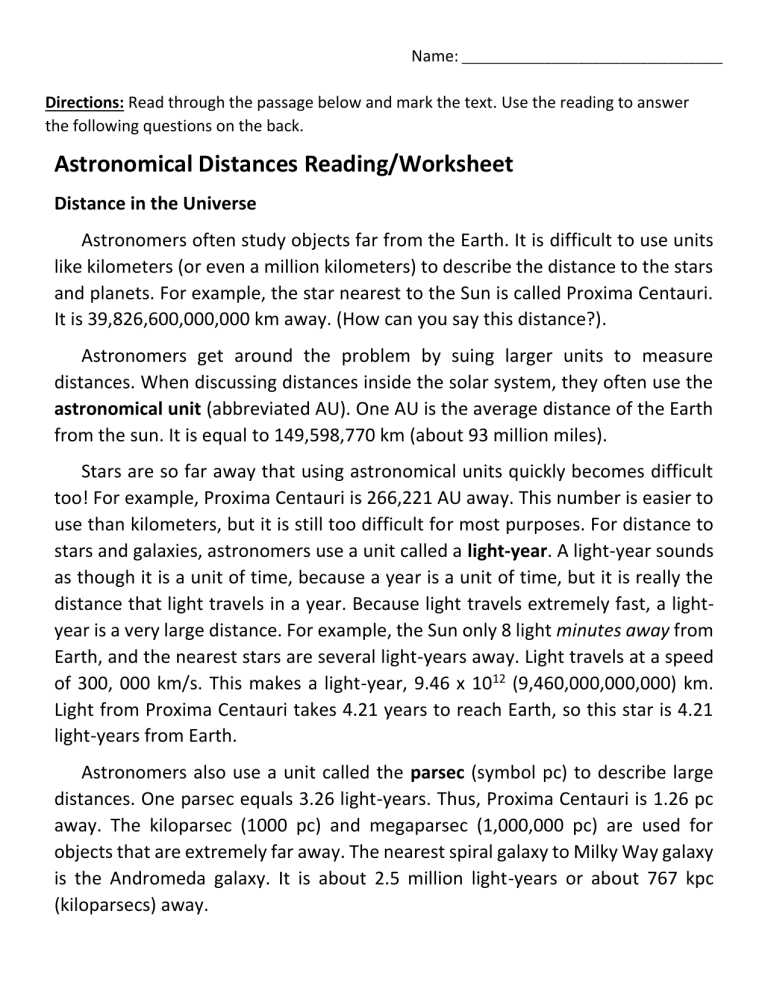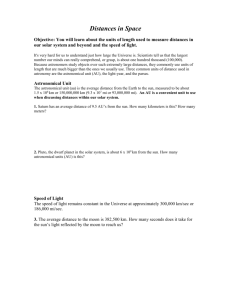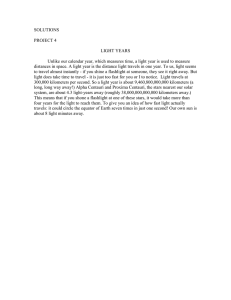
Name: ______________________________________ Directions: Read through the passage below and mark the text. Use the reading to answer the following questions on the back. Astronomical Distances Reading/Worksheet Distance in the Universe Astronomers often study objects far from the Earth. It is difficult to use units like kilometers (or even a million kilometers) to describe the distance to the stars and planets. For example, the star nearest to the Sun is called Proxima Centauri. It is 39,826,600,000,000 km away. (How can you say this distance?). Astronomers get around the problem by suing larger units to measure distances. When discussing distances inside the solar system, they often use the astronomical unit (abbreviated AU). One AU is the average distance of the Earth from the sun. It is equal to 149,598,770 km (about 93 million miles). Stars are so far away that using astronomical units quickly becomes difficult too! For example, Proxima Centauri is 266,221 AU away. This number is easier to use than kilometers, but it is still too difficult for most purposes. For distance to stars and galaxies, astronomers use a unit called a light-year. A light-year sounds as though it is a unit of time, because a year is a unit of time, but it is really the distance that light travels in a year. Because light travels extremely fast, a lightyear is a very large distance. For example, the Sun only 8 light minutes away from Earth, and the nearest stars are several light-years away. Light travels at a speed of 300, 000 km/s. This makes a light-year, 9.46 x 1012 (9,460,000,000,000) km. Light from Proxima Centauri takes 4.21 years to reach Earth, so this star is 4.21 light-years from Earth. Astronomers also use a unit called the parsec (symbol pc) to describe large distances. One parsec equals 3.26 light-years. Thus, Proxima Centauri is 1.26 pc away. The kiloparsec (1000 pc) and megaparsec (1,000,000 pc) are used for objects that are extremely far away. The nearest spiral galaxy to Milky Way galaxy is the Andromeda galaxy. It is about 2.5 million light-years or about 767 kpc (kiloparsecs) away. Use the reading to answer the following questions: 1. What is an astronomical unit? 2. When do we use AUs? 3. What is a light-year? 4. When do we use a light-year? 5. What is a parsec? 6. When do we use a parsec? Use the previous information and the following word bank to answer questions 7-13 below. Light-year Kilometers 7. WORD BANK AU Meters Parsec Nanometers Centimeters List each unit in the box above from SMALLEST to LARGEST: Determine the unit you would use to find the distance: 8. The distance from the earth to the moon. _______________________ 9. The distance from the door of the classroom to the parking lot___________________ 10. The distance from one red blood cell to the nearest red blood cell_________________ 11. The distance from Earth to another galaxy _______________________ 12. The distance from Earth to the nearest star ______________________ 13. The distance from the tip of your pointer finger to your wrist. ____________________




